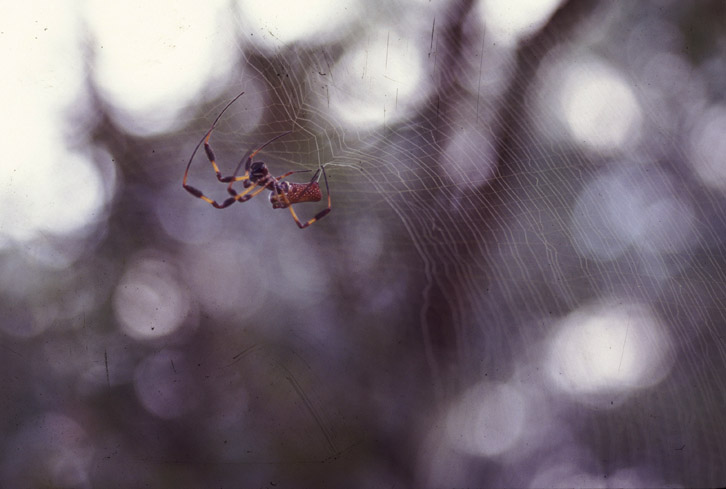
Yes, another muted color example, and I’m often enthusiastic about the vibrancy of slides (it just means the scene was really bland.) We’ll get into some nice color shortly. For this week we have a dual illustration, which is clear the moment you look closely. First off, Florida is home to more than a few examples of this massive spider, a female golden silk orbweaver (Nephila clavipes) – the bodies alone can be the size of your finger, which can make the leg spread larger than your palm. Their webs may be as large as 2 meters across, and while they’re usually up in the branches out of immediate encounter range, not always. I have distinct memories of my brother’s ejaculation of foul language when he nearly walked into a web at chest level; he still lives in New York and isn’t used to the subtropical effect on species size.
What I managed to capture in this was a curious trait of their webs, which is how the spiraling circular strands seem to run in close parallel pairs, like train tracks, as if laid down at the same time. While it’s possible that this is the case, and the golden silk orbweaver possesses a radical set of spinnerets, it’s not consistent, and possibly only due to a habit of their casting process. Nothing that I’ve found has made mention of this trait, so I can offer no explanation either way. I was pleased, however, to have captured the details of the web distinctly enough, something that often isn’t possible without some helpful mist or dew.
But also visible is how badly damaged this slide is, and I don’t recall how this happened. Some of it is dust, but the lines aren’t; this one got badly scratched somewhere along the way. And with detail like this, it’s damn hard and time-consuming to edit it all back out in Photoshop. I’m sure plenty of people would point out how much better digital images are over film in this regard, which is true – to a point. Because digital files get damaged too, and when they do, there’s usually no saving them. You don’t get little blotches and lines and so on, you have entire portions that simply go blank, if the file opens at all. And the nature of digital is, they will go corrupt: media degrades, hard drives fail, sectors go bad. Constant duplication is necessary, and while not particularly difficult, fate is entirely unforgiving if you fail to maintain decent and regular backups.
Meanwhile, I can touch up these images, including doing a rescan with a hint of nose grease or mineral oil applied to the slide, which does a remarkable job of vanishing such scratches. This slide dates from 2001, if I remember right, and I started first shooting digital in 2003. Almost none of the original digital media from that time survives in readable form, and I only have access to those digital images through repeated copying, while this slide (and thousands of others without such damage) will be viable for quite a while yet. Perspective is important.
















































